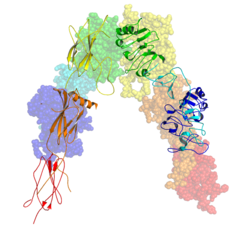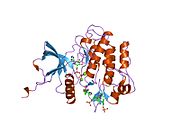Insulinski receptor
| edit |
Insulinski receptor (IR) je transmembranski receptor koji aktiviraju insulin, IGF-I, IGF-II, i koji pripada velikoj klasi receptorskih tirozinskih kinaza.[1] U pogledu metabolizma, insulinskih receptor ima ključnu ulogu u regulaciji glukozne homeostaze, funkcionalnog procesa koji pod degenerivnim okolnostima može da dovede do niza kliničkih manifestacija, uključujući dijabetes i kancer.[2][3] Biohemijski, insulinski receptor je kodiran jednim genom INSR, iz koga se alternativnim splajsovanjem tokom transkripcije formiraju bilo IR-A ili IR-B izoforma.[4] Dalje posttranslacione izmene ovih izoformi dovode do formiranja proteolitički skraćenih α i β podjedinica, koje nakon kombinovanja imaju sposobnost formiranja homo ili hetero-dimera, čime nastaje ≈320 kDa disulfidno vezani transmembranski insulinski receptor.[4]
Interakcije[uredi | uredi kod]
Insulinski receptor formira interakcije sa Ektonukleotidnom pirofosfatazom/fosfodiesterazom 1,[5] PTPN11,[6][7] GRB10,[8][9][10][11][12] GRB7,[13] PRKCD,[14][15] IRS1,[16][17] SH2B1[18][19] i MAD2L1.[20]
Reference[uredi | uredi kod]
- ↑ Ward CW, Lawrence MC (April 2009). „Ligand-induced activation of the insulin receptor: a multi-step process involving structural changes in both the ligand and the receptor”. BioEssays 31 (4): 422–34. DOI:10.1002/bies.200800210. PMID 19274663.
- ↑ Ebina Y, Ellis L (April 1985). „The human insulin receptor cDNA: the structural basis for hormone-activated transmembrane signalling.”. Cell 40 (4): 747–58. DOI:10.1016/0092-8674(85)90334-4. PMID 2859121.
- ↑ Malaguarnera R, Belfiore A (February 2012). „Proinsulin Binds with High Affinity the Insulin Receptor Isoform A and Predominantly Activates the Mitogenic Pathway.”. Endocrinology. Epub (5): 2152–63. DOI:10.1210/en.2011-1843. PMID 22355074.
- ↑ 4,0 4,1 Belfiore A, Frasca F (Oct 2009). „Insulin receptor isoforms and insulin receptor/insulin-like growth factor receptor hybrids in physiology and disease.”. Endocr Rev 30 (6): 586–623. DOI:10.1210/er.2008-0047. PMID 19752219.
- ↑ Maddux, B A; Goldfine I D (Jan 2000). „Membrane glycoprotein PC-1 inhibition of insulin receptor function occurs via direct interaction with the receptor alpha-subunit”. Diabetes (UNITED STATES) 49 (1): 13–9. DOI:10.2337/diabetes.49.1.13. ISSN 0012-1797. PMID 10615944.
- ↑ Maegawa, H; Ugi S; Adachi M; Hinoda Y; Kikkawa R; Yachi A; Shigeta Y; Kashiwagi A (Mar 1994). „Insulin receptor kinase phosphorylates protein tyrosine phosphatase containing Src homology 2 regions and modulates its PTPase activity in vitro”. Biochem. Biophys. Res. Commun. (UNITED STATES) 199 (2): 780–5. DOI:10.1006/bbrc.1994.1297. ISSN 0006-291X. PMID 8135823.
- ↑ Kharitonenkov, A; Schnekenburger J; Chen Z; Knyazev P; Ali S; Zwick E; White M; Ullrich A (Dec 1995). „Adapter function of protein-tyrosine phosphatase 1D in insulin receptor/insulin receptor substrate-1 interaction”. J. Biol. Chem. (UNITED STATES) 270 (49): 29189–93. DOI:10.1074/jbc.270.49.29189. ISSN 0021-9258. PMID 7493946.
- ↑ Langlais, P; Dong L Q; Hu D; Liu F (Jun 2000). „Identification of Grb10 as a direct substrate for members of the Src tyrosine kinase family”. Oncogene (ENGLAND) 19 (25): 2895–903. DOI:10.1038/sj.onc.1203616. ISSN 0950-9232. PMID 10871840.
- ↑ Hansen, H; Svensson U; Zhu J; Laviola L; Giorgino F; Wolf G; Smith R J; Riedel H (Apr 1996). „Interaction between the Grb10 SH2 domain and the insulin receptor carboxyl terminus”. J. Biol. Chem. (UNITED STATES) 271 (15): 8882–6. DOI:10.1074/jbc.271.15.8882. ISSN 0021-9258. PMID 8621530.
- ↑ Liu, F; Roth R A (Oct 1995). „Grb-IR: a SH2-domain-containing protein that binds to the insulin receptor and inhibits its function”. Proc. Natl. Acad. Sci. U.S.A. (UNITED STATES) 92 (22): 10287–91. Bibcode 1995PNAS...9210287L. DOI:10.1073/pnas.92.22.10287. ISSN 0027-8424. PMC 40781. PMID 7479769.
- ↑ He, W; Rose D W; Olefsky J M; Gustafson T A (Mar 1998). „Grb10 interacts differentially with the insulin receptor, insulin-like growth factor I receptor, and epidermal growth factor receptor via the Grb10 Src homology 2 (SH2) domain and a second novel domain located between the pleckstrin homology and SH2 domains”. J. Biol. Chem. (UNITED STATES) 273 (12): 6860–7. DOI:10.1074/jbc.273.12.6860. ISSN 0021-9258. PMID 9506989.
- ↑ Frantz, J D; Giorgetti-Peraldi S; Ottinger E A; Shoelson S E (Jan 1997). „Human GRB-IRbeta/GRB10. Splice variants of an insulin and growth factor receptor-binding protein with PH and SH2 domains”. J. Biol. Chem. (UNITED STATES) 272 (5): 2659–67. DOI:10.1074/jbc.272.5.2659. ISSN 0021-9258. PMID 9006901.
- ↑ Kasus-Jacobi, A; Béréziat V; Perdereau D; Girard J; Burnol A F (Apr 2000). „Evidence for an interaction between the insulin receptor and Grb7. A role for two of its binding domains, PIR and SH2”. Oncogene (ENGLAND) 19 (16): 2052–9. DOI:10.1038/sj.onc.1203469. ISSN 0950-9232. PMID 10803466.
- ↑ Braiman, L; Alt A; Kuroki T; Ohba M; Bak A; Tennenbaum T; Sampson S R (Apr 2001). „Insulin induces specific interaction between insulin receptor and protein kinase C delta in primary cultured skeletal muscle”. Mol. Endocrinol. (United States) 15 (4): 565–74. DOI:10.1210/mend.15.4.0612. ISSN 0888-8809. PMID 11266508.
- ↑ Rosenzweig, Tovit; Braiman Liora; Bak Asia; Alt Addy; Kuroki Toshio; Sampson Sanford R (Jun 2002). „Differential effects of tumor necrosis factor-alpha on protein kinase C isoforms alpha and delta mediate inhibition of insulin receptor signaling”. Diabetes (United States) 51 (6): 1921–30. DOI:10.2337/diabetes.51.6.1921. ISSN 0012-1797. PMID 12031982.
- ↑ Aguirre, Vincent; Werner Eric D; Giraud Jodel; Lee Yong Hee; Shoelson Steve E; White Morris F (Jan 2002). „Phosphorylation of Ser307 in insulin receptor substrate-1 blocks interactions with the insulin receptor and inhibits insulin action”. J. Biol. Chem. (United States) 277 (2): 1531–7. DOI:10.1074/jbc.M101521200. ISSN 0021-9258. PMID 11606564.
- ↑ Sawka-Verhelle, D; Tartare-Deckert S, White M F, Van Obberghen E (Mar 1996). „Insulin receptor substrate-2 binds to the insulin receptor through its phosphotyrosine-binding domain and through a newly identified domain comprising amino acids 591–786”. J. Biol. Chem. (UNITED STATES) 271 (11): 5980–3. DOI:10.1074/jbc.271.11.5980. ISSN 0021-9258. PMID 8626379.
- ↑ Kotani, K; Wilden P; Pillay T S (Oct 1998). „SH2-Balpha is an insulin-receptor adapter protein and substrate that interacts with the activation loop of the insulin-receptor kinase”. Biochem. J. (ENGLAND) 335 (1): 103–9. ISSN 0264-6021. PMC 1219757. PMID 9742218.
- ↑ Nelms, K; O'Neill T J; Li S; Hubbard S R; Gustafson T A; Paul W E (Dec 1999). „Alternative splicing, gene localization, and binding of SH2-B to the insulin receptor kinase domain”. Mamm. Genome (UNITED STATES) 10 (12): 1160–7. DOI:10.1007/s003359901183. ISSN 0938-8990. PMID 10594240.
- ↑ O'Neill, T J; Zhu Y; Gustafson T A (Apr 1997). „Interaction of MAD2 with the carboxyl terminus of the insulin receptor but not with the IGFIR. Evidence for release from the insulin receptor after activation”. J. Biol. Chem. (UNITED STATES) 272 (15): 10035–40. DOI:10.1074/jbc.272.15.10035. ISSN 0021-9258. PMID 9092546.
Literatura[uredi | uredi kod]
- Pearson RB, Kemp BE (1991). „Protein kinase phosphorylation site sequences and consensus specificity motifs: tabulations”. Meth. Enzymol. 200: 62–81. DOI:10.1016/0076-6879(91)00127-I. PMID 1956339.
- Joost HG (1995). „Structural and functional heterogeneity of insulin receptors”. Cell. Signal. 7 (2): 85–91. DOI:10.1016/0898-6568(94)00071-I. PMID 7794689.
- O'Dell SD, Day IN (1998). „Insulin-like growth factor II (IGF-II)”. Int. J. Biochem. Cell Biol. 30 (7): 767–71. DOI:10.1016/S1357-2725(98)00048-X. PMID 9722981.
- Lopaczynski W (1999). „Differential regulation of signaling pathways for insulin and insulin-like growth factor I”. Acta Biochim. Pol. 46 (1): 51–60. PMID 10453981.
- Sasaoka T, Kobayashi M (2000). „The functional significance of Shc in insulin signaling as a substrate of the insulin receptor”. Endocr. J. 47 (4): 373–81. DOI:10.1507/endocrj.47.373. PMID 11075717.
- Perz M, Torlińska T (2001). „Insulin receptor—structural and functional characteristics”. Med. Sci. Monit. 7 (1): 169–77. PMID 11208515.
- Benaim G, Villalobo A (2002). „Phosphorylation of calmodulin. Functional implications”. Eur. J. Biochem. 269 (15): 3619–31. DOI:10.1046/j.1432-1033.2002.03038.x. PMID 12153558.





